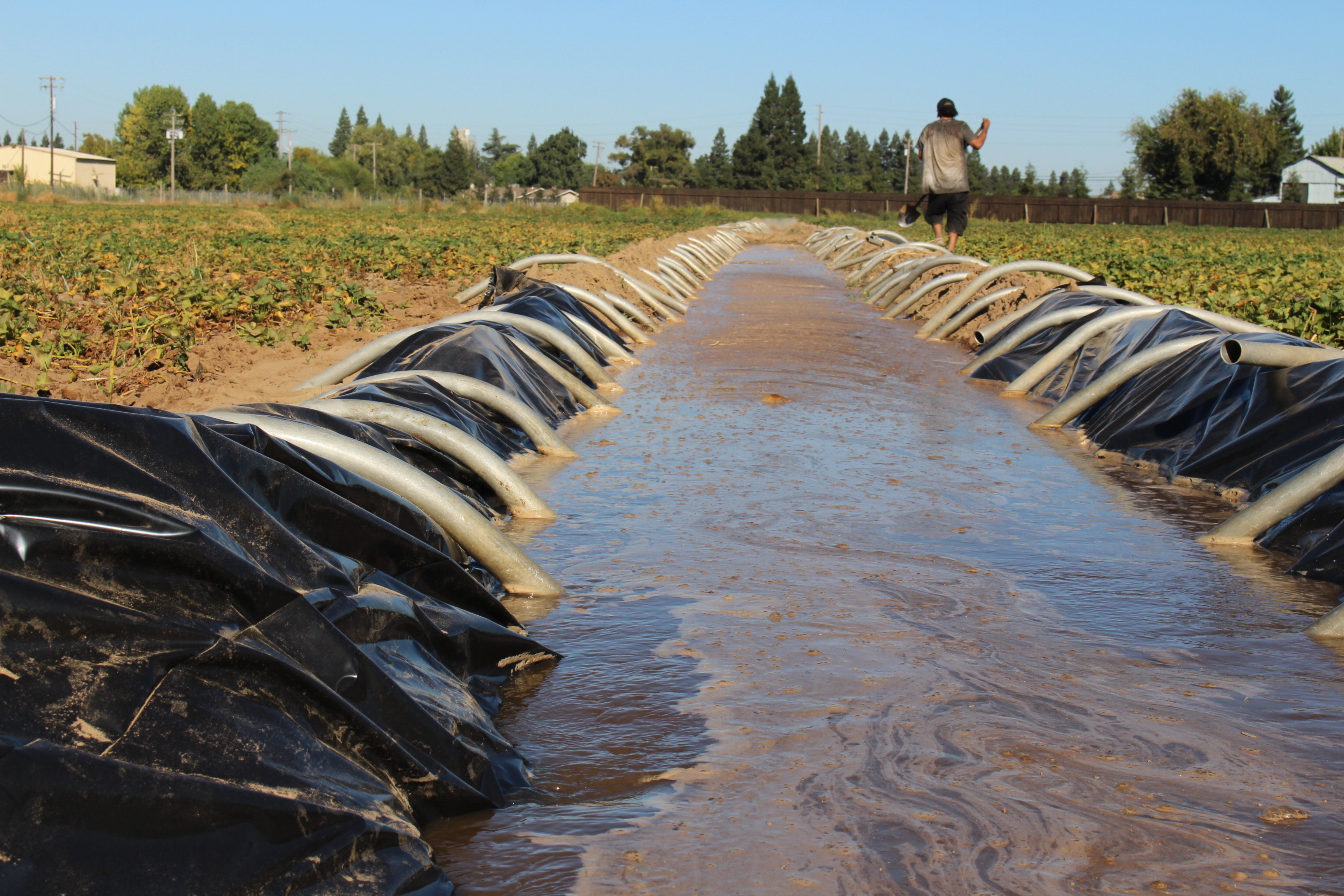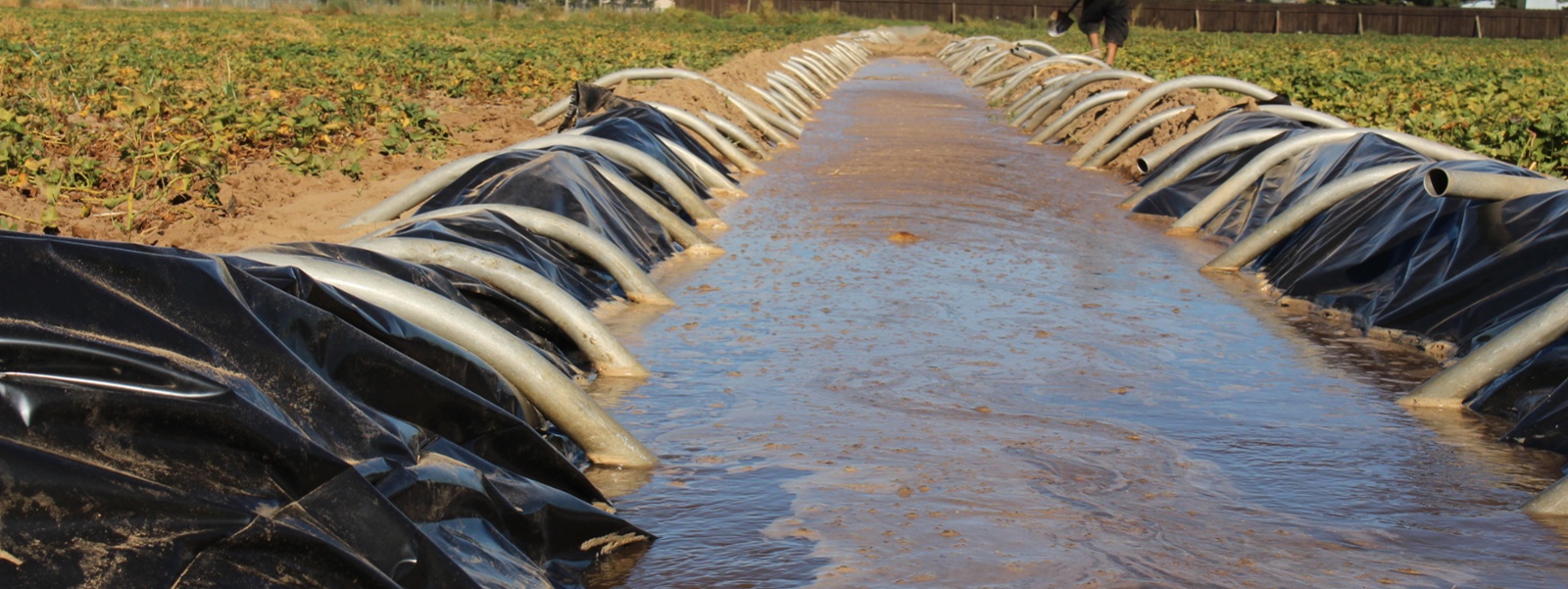Done right, flooding fields can be efficient

In this sweet potato field in Stanislaus County, siphon pipes transport water through gravity to flood the furrows between the crop during irrigation.
Photo/Christine Souza

By Ching Lee
With their orchards, vineyards and high-value crops, California farmers have embraced drip and other forms of microirrigation, making such systems the leading method used to water their crops.
Despite increased adoption of drip, the traditional and more low-tech method of flooding the ground and using gravity to deliver water to crops remains popular in the Golden State—and not just for field crops. Less popular in California are sprinkler systems, even though they remain the most widely used irrigation method in the nation.
There’s a reason microirrigation has taken off. Drip systems, in general, improve irrigation efficiency, said Khaled Bali, an irrigation water management specialist at the University of California Kearney Agricultural Research and Extension Center in Parlier. With improved irrigation efficiency, farmers can produce higher yields per unit of applied water, he added.
Having endured crushing impacts of drought and regulatory water restrictions, California farmers have looked to improve their water footprint by being more precise in how they apply water so that every drop is used judiciously. At the same time, flood irrigation has faced increased scrutiny for being inefficient—even wasteful.
Bali rejects this misconception about flood irrigation. He said people who encounter a flooded field and see runoff may immediately think it is an inefficient way to irrigate. But with automation and other design improvements, farmers could maximize efficiency with flood and surface irrigation systems. There are also ways to capture runoff and reuse it.
“Flood irrigation doesn’t waste water,” Bali said. “The fact is it could be as efficient as other pressurized irrigation systems—and friendly to the environment.”
The most recent Census of Irrigation in 2018 by the U.S. Department of Agriculture shows more than 3.8 million acres in California were irrigated using gravity systems compared to 4 million acres using microirrigation and 952,038 acres using sprinkler systems.
Just five years prior, gravity systems were still the No. 1 method used by California farmers, with more than 4.5 million acres. The 2013 survey showed microirrigation was used on nearly 2.8 million acres and sprinkler systems on 1.6 million acres.
Charles Hillyer, director of the Fresno State University Center for Irrigation Technology, distinguishes irrigation efficiency from application efficiency. The former refers to how much water was beneficially used relative to how much water was delivered. Irrigation efficiency is determined primarily by management, he said, whereas application efficiency is determined by the technology used and refers to how much water coming out of the system stayed in the soil and didn’t run off or evaporate.
“You can invest thousands of dollars an acre on a drip irrigation system that has absolutely fantastic application efficiency, but if you don’t invest anything in management, you’re basically spending a whole lot of money to mismanage your water,” Hillyer said.
With the right flood irrigation design, Bali said farmers can control how much flow goes into a field, achieving 85% to 95% efficiency, which is very similar to pressurized systems such as drip or sprinkler irrigation.
“When everything is just right,” Hillyer said, all three types of systems come close to achieving application efficiency, though it’s more difficult to do with surface, or flood, irrigation, as it requires the right soil conditions and laser-leveled fields with the right slope. Furrows also need to be the right length based on the soil type and infiltration rates, and check structures may need to be installed to control the water.
“If you’re talking about reality on the ground, surface does tend to get a bad reputation,” he said. “It’s easy to do it badly. It’s hard to do it well, but it can be done well.”
Ronnie Leimgruber, who grows field crops and vegetables in the Imperial Valley, said inefficiency in flood irrigation tends to be the result of overwatering and too much deep percolation, which can be overcome by irrigating smaller sections of the field with increased volumes of water.
“The more water you can apply, the faster it gets over the field, the more efficient it is,” he said.
On his field crops, he uses an automated flood system that opens and closes field gates when sensors are triggered. To eliminate human error—another inefficiency—and reduce labor costs, he uses a software that monitors his crop, soil moisture and irrigation to determine how much water to add. Though he also uses drip and different sprinkler systems, he said flooding is by far the foremost way he irrigates.
“We’re reaching close to 90% efficiency on our irrigation systems,” Leimgruber said. “We’re pushing the envelope on flood irrigation.”
Leimgruber said he measures a system’s efficiency not just by its water usage but by other environmental impacts such as fuel and energy usage, and plastic and metal pollution typically generated by drip and sprinkler systems. Another environmental benefit of flood irrigation is the habitat it creates for birds and wildlife, he noted.
Leimgruber maintains that drip irrigation—which he uses on limited acres of alfalfa—remains one of the highest in water-use efficiency, but he said it also takes a lot more labor, management and expense. If not for federal and local water conservation subsidies, he said, he would not be able to afford to install and maintain the costly systems, especially on a lower-value crop such as alfalfa.
When switching from flood to drip, UC’s Bali said farmers could end up spending $3,000 to $5,000 an acre more on just energy. Even though water-use efficiency is higher on drip, he said, it does not necessarily translate to water savings, “because you still use the same amount of water, but you’re getting more yield.” With subsurface drip on alfalfa, for example, yields could increase by as much as 15% to 20%, he noted.
Chris Jergenson, who farms in Merced and Stanislaus counties, said he prefers flood irrigation on his sweet potatoes and tree crops such as peaches and almonds, noting the system’s simplicity, low maintenance and energy savings. Compared to drip, in which water goes directly to the plant’s roots, he said he likes how flooding can cover the entire field or orchard floor, allowing water to go deeper into the soil to reach tiny feeder roots “that are hugely beneficial” to the trees. This contributes to more robust root systems.
Because flood irrigation relies on gravity to transport water, the process requires no diesel or electricity. Unlike drip or sprinkler systems, flooding does not require expensive equipment or extensive infrastructure. That means no broken sprinkler heads, hose lines or pumps to fix, Jergenson said. Rather than having to run water for three to four days with a drip system, flooding takes him about five to six hours to irrigate, he said, “and I don’t have to come back for 10 to 14 days, depending on the weather.”
Another benefit to flood irrigation is its ability to flush soils and help remove salt from the land. What’s more, there’s no need to set up gopher traps, he said.
“When you flood, they just all run out, and then the owls or the hawks will kill them,” Jergenson said.
When choosing an irrigation system, UC’s Bali said farmers must consider a variety of factors.
“In general, there’s no best irrigation system,” he said. “You just need to find the system that works for the particular crop and soil type.”
(Ching Lee is an assistant editor of Ag Alert. She may be contacted at clee@cfbf.com.)




